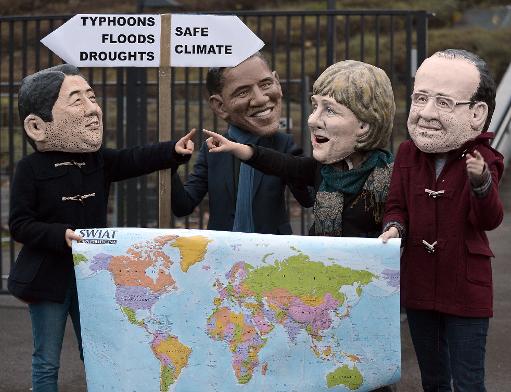Sublime Text 2 is a text editor for OS X, Linux and Windows, currently in beta.

 fix minimap scrolls to wrong place on click
fix minimap scrolls to wrong place on click

 Api to draw into the editor?
Api to draw into the editor?
Is there any api to draw an overlay under some rows?
I want to do something like this: https://twitter.com/patrick91/status/375999782444990464/photo/1

 Warsaw Climate Change Conference Inconclusively Concludes
Warsaw Climate Change Conference Inconclusively Concludes
Warsaw Climate Change Conference Inconclusively Concludes

Warsaw-"For the third year in a row the (member) countries have found a new way to say absolutely nothing," asserted Oxfam director Winnie Byanyima, as the U.N.’s annual climate change conference limped inconsequentially to its end on Saturday in Warsaw. The 19th Conference of the Parties (COP-19) to the U.N. Framework Convention of Climate Change (UNFCCC) was supposed to set out a roadmap toward completing a global treaty that would bind all countries to some kind of commitments to reduce their greenhouse gas emissions after 2020 at the Paris COP-21 in 2015. No commitments were made and no clear roadmap was adopted at the Warsaw talks.
Citing the “historical responsibility” of rich countries for causing climate change, China, India, Brazil, South Africa and other developing countries want to maintain the original obligation established in the 1992 UNFCCC that only developed countries are required to do anything about man-made climate change. In the agreement reached at Warsaw, the developing countries, including the largest and fourth largest emitters of greenhouse gases—China and India—forced the rich countries to drop their insistence that all countries make “commitments” to address climate change. Instead, countries will now make vague nationally determined “contributions” toward addressing man-made global warming.
The United States and European negotiators in Warsaw had sought an agreement in which each country would use a common transparent framework for calculating its emissions reductions. In the new Warsaw agreement, countries set their own baselines and define their own reduction strategies, thus making comparisons between countries’ efforts far less transparent and harder to calculate.
The developed country negotiators also wanted all countries to put forward their initial commitments no later than the first quarter of 2015. That deadline would make it possible for the initial commitments to be critiqued before the 2015 Paris conference. The goal of the pre-Paris scrutiny would be to see if they were collectively adequate to keep the world on track toward restraining future global temperatures to an increase of no more than two degrees centigrade. Instead, countries will announce their contributions only when they were good and “ready to do so.”
The poor countries also demanded that the rich countries make commitments to establish a new bureaucratic mechanism under the UNFCCC to compensate them for the loss and damage caused by climate change. For their part, the rich countries did not want to create a new international agency that would be empowered to make them legally liable for weather damage anywhere in the world. The Warsaw agreements reached a compromise in which a Warsaw mechanism for loss and damage will be set up under the existing institutions that are supposed to fund projects that help poor countries to adapt to climate change. That decision, however, will be reviewed after three years.
In 2009, at the Copenhagen climate change conference, the rich countries committed to “mobilizing” $100 billion annually by 2020 to help poor countries to cope with climate change. At Warsaw, the poor countries sought to get the rich countries to pledge that they would hand over $70 billion per year by 2016 as an interim measure. The developing countries also wanted to make it clear that the climate change financing should be “mobilized” from public, not private funds. At Warsaw, the rich countries refused to make specific interim financial commitments, although they did agree to file biennial reports outlining what their plans are for funding climate change adaptation for poor countries between now and 2020.
So the Warsaw conference ended with no firm commitments on either greenhouse gas emissions or on finance. The diplomats and the activists will convene to do it all over again next year in Lima, Peru.
Source: Global Treaty

 please add wrap paragraph support on os x
please add wrap paragraph support on os x

 Westhill Property Consulting London
Westhill Property Consulting London
U.S. millionaires see real estate as the top alternative-asset class to own this year, according to Morgan Stanley. (MS)
About 77 percent of investors with at least $1 million in assets own real estate, according to a survey released today by the New York-based investment bank’s wealth-management unit. Direct ownership of residential and commercial properties was the No. 1 alternative-investment pick for 2014, with a third of millionaire’s surveyed saying they plan to buy this year. Twenty-three percent said they expect to invest in real estate investment trusts, the second-most popular choice.
Wealthy investors are turning to a rebounding real estate market as fixed-income yields remain historically low and equities surge. U.S. commercial-property values rose 8 percent in the 12 months ended Jan. 31, and have jumped 71 percent since hitting their post-recession bottom in 2009, research firm Green Street Advisors Inc. reported today. The S&P/Case-Shiller index of home prices in 20 cities is up 24 percent from its 2012 low.
“After a year where the Standard & Poor’s Index rose 30 percent, some millionaires are moving money out of traditional, long-only strategies to find outperformance, and turning toward alternatives such as real estate and private equity,” said Gary Kaminsky, a vice chairman at Morgan Stanley Wealth Management in New York. “Sophisticated, high-net-worth investors are much more concerned about losses.”
Photographer: Victor J. Blue/Bloomberg
The One57 residential building stands while under construction in New York.
Collectibles ranked as the third-most-popular alternative-investment choice this year, with 20 percent of millionaires saying they planned to buy, followed by private equity at 19 percent and precious metals at 16 percent.
Interest Rates
Wealthy investors see stocks getting expensive and interest rates staying stable or even declining over the next couple of years, Kaminsky said in an interview at a conference for Tiger 21 investors last week in Scottsdale, Arizona. That’s why they are looking more closely at alternatives including real estate for returns and income, he said.
Tiger 21 members, who have at least $10 million in investable assets, increased their average allocation to real estate last year to 21 percent as of the fourth quarter from 19 percent in the first three months of 2013, according to a separate study released by the New York-based group last month.
Will Ade, a Tiger 21 member, said real estate is a particularly attractive investment as stocks show vulnerability in 2014. The S&P 500 has fallen more than 4 percent this year, while developing-country stocks have tumbled on concern that the outlook for economies is worsening.
‘Lame’ Bull
“We had a great bull run last year,” Ade, a 60-year-old geologist, said in an interview today. “I don’t know if the bull is dead, but it certainly is lame right now.”
This year may be the tail-end of attractive investments in property before interest rates rise, said Ade, who has made his money finding oil companies and private investors to fund the drilling of wells. He said he is trying to purchase residential real estate in Miami right now.
“The really good real estate deals are getting harder and harder to find,” Ade said. “Once interest rates start to go up, whether it’s farmland or single-family dwellings there’s going to be huge downward pressure on real estate.”
Foreign Buyers
The Manhattan high-rise condominium buildings One57 and 432 Park Ave., where units have gone under contract for more than $90 million, are evidence of the faith that the very wealthy have in real estate, said Mitchell Roschelle, real estate advisory leader at PricewaterhouseCoopers LLP. Such properties have also attracted international buyers.
Wealthy foreigners have bought high-end U.S. properties for their safety and because they’re denominated in dollars, the world’s reserve currency, he said. This helps domestic millionaires maintain the value of their property investments.
“It creates competition, which drives the price up for everybody,” he said. “The sellers have multiple channels to sell into. That gives you more liquidity.”
Self-storage properties are among commercial real estate investments wealthy individuals are buying, Kaminsky of Morgan Stanley said. Retail shopping centers are seen as less attractive as more consumers shop online through companies such as Amazon.com Inc., he said.
Chilean Fund
Morgan Stanley Wealth Management surveyed 1,004 U.S. investors ages 25 to 75, with least $100,000 in assets, during the fourth quarter of last year. A third of them had more than $1 million.
BigSur Partners, a Miami-based wealth-management firm, has been helping some of its wealthy clients, who usually have at least $50 million, work with institutional investors such as a Chilean pension fund to invest in commercial real estate, said Chief Executive Officer Ignacio Pakciarz. Deals include an office building in Princeton, New Jersey, he said.
“We don’t feel there’s a lot of value in emerging-market bonds, high-yield bonds and highly rated fixed income,” Pakciarz said.
Owning the real estate is attractive because of the expected appreciation of property value and stream of rental income, as well as better control and supervision over the investments, he said.
For more information:
Westhill Property Consulting London | Contact
Westhill Property Consulting London | Result

 Allow the use of +<linenumber> in the command line to open a file and jump to that line
Allow the use of +<linenumber> in the command line to open a file and jump to that line

 Pin folder to Sublime in taskbar in Windows 7
Pin folder to Sublime in taskbar in Windows 7

 Double click empty area on the side bar to create a new file
Double click empty area on the side bar to create a new file

 Westhill Consulting Travel and Tours
Westhill Consulting Travel and Tours
When looking for the perfect holiday destination, don’t choose the conventional Holiday; instead go on an exciting and exotic trip. It is this type of vacation that will bring you the most memories. You can do this with the help of Westhill Consulting.
The thought of traveling to the Maldives, the carribean, the Middle East, Indonesia and many other exotic and interesting destinations is interesting and exciting. But planning this type of trip on your own is quite unnerving. Sure, you can book the airplane, but what comes next? What places do you visit once you are there? How do you communicate?
These are all questions that start coming up. What to Do? Actually, the solution is pretty simple. Instead of booking your own flight and hotel, you could hire the services of a company like Westhill Consulting Travel and Tours. Westhill was founded by a group of avid travelers. Those that go to out of the way places, study the area s culture and learn of the people.
They know of the sights and interesting activities that are of interest to travelers. It is the travel services offered by this type of experienced traveler that can add the depth and color you expect from any exotic trip you choose. On a Budget? Even when you have a specific budget for your trip, and this doesn’t t allow for a lot of expense, Westhill Consulting and Tours can help organize and put together the most exciting trip of your life.
Where Can I Go? There are thousands of interesting destinations throughout the world, and that can make it difficult to choose the one you want. Some destinations you may not even know about. To learn a little about some of the most interesting places in the world, visit the Westhill Consulting Blog. There you’ll learn of some of the most interesting places to visit.
For more information:
Westhill Consulting Travel & Tours | Quora
Jakarta Travel Tips Westhill Consulting Travel & Tours
Westhill Consulting Travel & Tours Singapore

 Westhill Consulting & Employment How to Give Yourself the Best Possible Chance of Landing A Job?
Westhill Consulting & Employment How to Give Yourself the Best Possible Chance of Landing A Job?
Keep At It
It can be disheartening when you’re looking for a job and nothing seems to come up of. The first thing to remember is that climbing a career ladder is tough and you’ll be up against some stiff competition. Companies can only see a limited number of people during their recruitment process so are often very picky when it comes to who gets to the interview stage. You need to bear this in mind and don’t give up when it seems like you’re just not getting anywhere at all.
Instead make sure that you look in different places for job adverts and keep applying for any that peak your interest. Don’t put all of your eggs in one basket and apply for one job at a time – get your application out there to as many companies as possible in order to give yourself the best possible chance of being successful.
Think Outside The Box
Sometimes you need to take the initiative and contact a company, even if they aren’t advertising jobs. It’s not recommended that you simply spam every company in your local area with letters, but if there is a company that you would love to work for – why not let them know? Companies generally like people that are passionate about a brand or product, so if they can see this passion in you then you never know they might give you a chance.
Sometimes the initial offer will be a work experience opportunity, but you should grab this with both hands if you can because you never know what this will lead to.
Brush Up Your CV
Before you start applying for jobs you need to make sure that your CV is on-point. Don’t just assume that because it was good enough a few years ago that it is good enough now, because trends change. It is a good idea to contact a local recruitment agency and ask them what they look for in a decent CV. You’ll also find loads of information on this online. It might not be necessary to start your CV from scratch, but you’ll probably need to make a few tweaks to the layout to make it perfect.
It goes without saying that your CV should have no spelling errors and be grammatically correct. Generally speaking your CV should be 2 pages long, with your work history and experience at the top of this. Remember that recruiters usually have lots of CV’s to read through; you don’t want to give them any excuse not to read yours.
Think about the layout of it – you want it to look crisp and easy to read. They will usually skim read a bunch of CV’s to see how they match and then spend longer reading the ones that they liked and thought suitable. A messy layout could mean that they dismiss you and your CV at the first stage and of course this is something that you want to avoid.
Interview Techniques
If you get through to the interview stage then firstly give yourself a massive pat on the back. We have seen how tough the world of recruitment is, so to get to this stage should be seen as a massive positive.
There are loads of places you can get interview hints and tips, so there is no need to go into one unprepared. One of the best pieces of advice that can be given to you about interviews is to make sure that you are organized and prepared. Don’t assume you can just read up on the company the night before – this will just leave you feeling stressed and anxious, which is not the best approach for a job interview.
Read up about the company before you go and write down a couple of questions that you would like to ask them. This could be to do with the company, its growth, its plans or even specific to the job role you are applying for. It is important that you show an interest, so asking questions is essential.
You also need to think about what they are likely to ask you – prepare answers for questions about your strengths, weaknesses and experience. You’ll usually be allowed to take interview notes in with you so have buzz words written down to remind you of your answers. Interviewers will generally allow for nerves but you still need to come across as confident as you can.
Remember, as well as assessing your suitability for the job role they’re also looking at how you are going to fit in with a team. They want someone that is out-going, friendly and confident so that they don’t have to worry about how you are going to fit in with the people you are working with. Even if you’re shaking on the inside, try and project positivity and confidence as much as possible.
Sealing The Deal
End the interview on a high note so that you feel positive. Ask them when you’re likely to hear from them and encourage them to contact you should they have any more questions that they want to ask you.
Remember, just because you have had a good interview that doesn’t mean you should give up looking. If you miss a couple of day’s job hunting, you could miss out on your dream job. Instead, keep at it and carry on applying for jobs until you land your dream job role!
Service d'assistance aux clients par UserEcho


